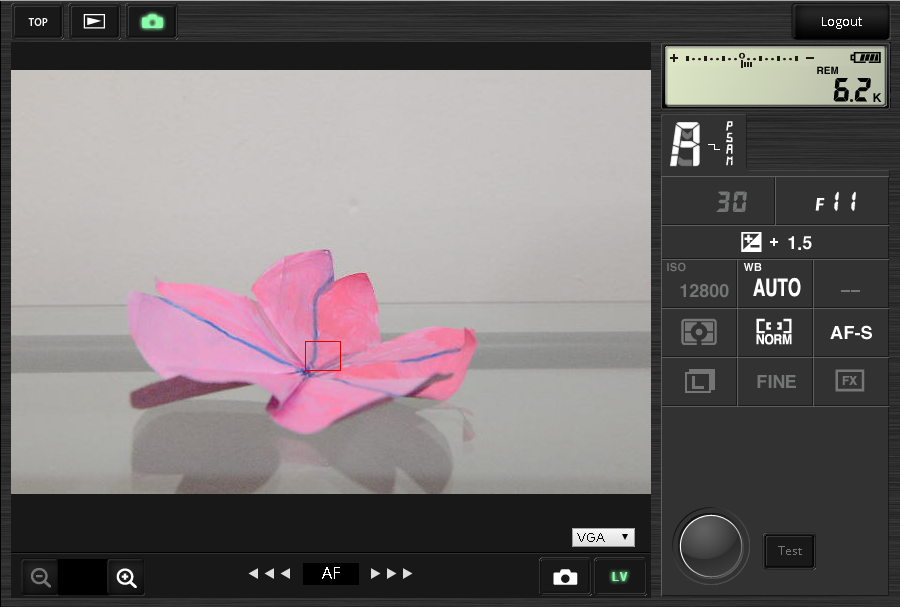Nikon D4 Review
Nikon D4 Introduction
The Nikon D4 is their top-of-the-line professional DSLR. This 16 megapixels full-frame DSLR is an imposing camera with two grips each having dual control-dials and a considerable amount of controls. Designed for high-performance, the D4 reaches a stellar ISO 204,800 and full-resolution continuous drive at 11 FPS for over 200 frames.
This DSLR is a powerhouse for professional photographers. It has every feature expected from its class and more like a built-in viewfinder shutter, built-in HTTP server, FTP client, wired Ethernet port and dual memory-card slots.
This extremely capable DSLR is compatible with Nikon FX lenses designed for full-frame digital and film cameras and Nikon's own Creative Lighting System for studio photography. There is a requisite hot-shoe plus a sync-port but no built-in flash. The D4 is remotely controllable by wired release, networked computer and even iPhone with the right accessory. Its highly customizable controls can be adjusted to various needs of photographers.
In this in-depth digital camera review, the Nikon D4 is analyzed in terms of features, usability, ergonomics, performance, image quality and controls.
Nikon D4 Features
Sensor
- 16 Megapixels CMOS sensor
- Full-Fame Nikon FX format
- Standard ISO 100 - 12,800 range
- Expanded ISO 50 - 204,800 range
- Customizable Auto ISO
- Built-in Dust-Reduction
- JPEG, TIFF, RAW or JPEG+RAW Output
Exposure
- PASM exposure modes
- 1/8000s - 30s Shutter-speed, plus Bulb
- EC, ±5 EV, 1/2 or 1/3 EV steps
- FC, -3...+1 EV, 1/2 or 1/3 EV steps
- Matrix, Center-Weighed, Average & Spot metering
- AEB, 2, 3 or 5 frames, maximum 3 EV steps, 7 or 9 frames, maximum 1 EV steps
- Flash Bracketing, 2 - 9 frames, maximum 1 EV steps
- Exposure Fine-Tuning, ±1 EV, 1/6 EV steps
- Exposure and ISO steps of 1, ½ or 1/3 EV
- HDR, 2 shots, 1-3 EV steps, 3 blending levels, single image or series
Focus & Drive
- 51-Point Phase-Detect autofocus system
- 15 cross-type points, 11 sensitive to F/8
- Autofocus sensitivity down to -2 EV
- Single-Shot and Continuous focus-drive
- Single-Point, Dynamic-Area and Auto focus-point
- 3D Tracking AF with OVF and Live-View
- Contrast-detect AF for Live-View and video
- Face-Detect AF in Live-View
- 11 FPS Drive, 170 JPEG or 75 RAW maximum at highest quality
- Customizable Self-Timer, 1-9 Shots, 2-20s Start Delay, ½-3s Interval
- Quiet-Shutter with delayed mirror-return
- Mirror-Up and Exposure-Delay, 1-3s
- Multiple-Exposure, 2-10 shots, optional Auto Gain
- Internal-Timer, 1-999 times, 1-9 shots, 1s-24h interval, delayed start 1m-23h59m
- Time-Lapse, 1s-10m interval, 1m-8h capture time
- Optional Autofocus Fine-Tuning
Images Parameters
- AutomaticTwo types: Normal & Preserve Warm Colors, Preset, Kelvin and Custom4 Memories WB
- Preset White-Balance fine-tuning, 2-axis, 13-steps
- Kelvin White-Balance fine-tuning, 1 axis, 13-steps
- Picture Styles, 6 built-in plus user-defined
- Automatic or Manual Sharpness, 10 steps
- Automatic or Manual Contrast, 7 steps
- Automatic or Manual Saturation, 7 steps
- Manually Adjustable Hue, 7 steps
- Manually Adjustable Tone-Curve, 3 levels
- Virtual WB Bracketing, 2-9 frames, 3 steps, 2 axis
- Virtual Active D-Lighting Bracketing, 2 - 5 frames
- Optional High-ISO Noise Reduction, 3 levels
- Optional Long Shutter Noise Reduction
- Optional Distortion-Correction
- Optional Vignetting-Correction
- Optional Active D-Lighting (ADL), 5 levels or Auto
- Optional Dust-Off reference photo
- In-Camera RAW development
Controls
- Dual control-dials for each grip
- 8-Way joysticks for each grip
- 8-Way controller for horizontal grip
- Configurable AF-On button for each grip
- Modeless exposure-mode button
- Modal drive-mode dial
- Independent AEB button
- Customizable Function button
- Customizable DOF-Preview button
- Customizable Video-Record button
- Customizable button in vertical grip
- Live-View trigger
- Focus-Point lock
Viewfinder & Displays
- 100% Coverage viewfinder, 0.7X magnification
- Built-in viewfinder shutter
- 3.2" LCD, 920K Pixels
- Illuminated top LCD status display
- Illuminated rear LCD status display
- Dual-Axis Digital-Level
- DOF-Preview in viewfinder
- Mechanical-Shutter Live-View
- Electronic-Shutter Live-View, 2 MP, 24 FPS
- Optional OVF composition grid
- Optional OVF overlay, 1.2X, DX or 5:4
- Sound-Level monitor
Body & Construction
- Nikon F-mount
- Weather-sealed body
- Integrated vertical grip
- Hot-Shoe and Sync-Port for external lighting
- Compact Flash memory slot
- XQD memory slot
- Proprietary Lithium-Ion battery
- Remove Live-View other Ethernet
- GPS or wired remote connector
- Built-in HTTP server
- Built-in FTP client
- 1080p HDMI output
- Metal tripod mount
Video
- 1920x1080 @ 30 FPS 16:9 HD Video
- 1280x720 @ 60 FPS 16:9 HD Video
- Built-in microphone, 20 levels
- Stereo sound-input mini-jack
- Stereo sound-output mini-jack
- Quicktime H.264 codec
- Index marking
Nikon D4 Capability - What can it do?
As the feature list shows and the 456-page manual will attest, the Nikon D4 is an incredible number of features, so it is easier to describe it by the few things not found on this DSLR! So, in this review-section, we cover those which the D4 does differently and unusual features.
The only real omission from this DSLR is a built-in flash. With its ultra-high ISO and fast drive, it does not really need one. External lighting is supported via a hot-shoe and sync-port. All standard flash features are part of the D4 though, but require a flash: Flash-Compensation, Flash-Mode and even Flash-Bracketing are all there. One thing to know for completeness is that Nikon uses lens-based stabilization and so none of their DSLR cameras have stabilization built-in. The same is true for Canon, leaving the only stabilized full-frame cameras to Sony.
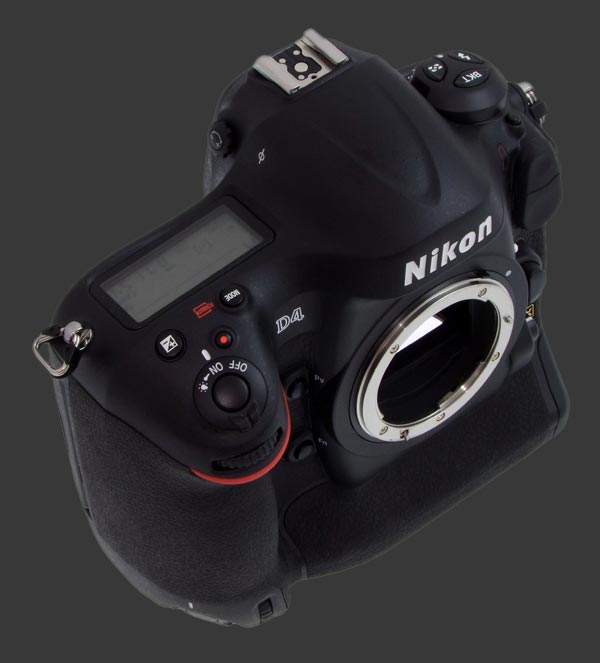
The Nikon D4 has a 3-way power-switch. Two positions are the usual On and Off choices. The third position is spring-loaded and triggers illumination of both status LCDs. Optionally, both status LCDs can be permanently illuminated while the camera is On. Even when the camera is off, the status LCD nicely indicates which card is inserted and how much space is available in the first occupied slot.
This DSLR offers a complete set of drive modes, most of them fairly obvious. There are two continuous drive modes. The fast one, CH, shoots at 11 or 10 FPS. The slow one, CL, shoots between 1 and 10 FPS. The only unusual mode is Q which stands for Quiet Shutter. It works by moving the mirror very slowly to reduce noise made by the camera. It also does not return the mirror to its up-position until the shutter is fully released. This can be useful for times when camera sounds are distracting.
There is one custom menu option which should truly be a drive mode: Exposure Delay Mode. This in-effect is a self-timer of between 1 and 3 seconds which raises the mirror up at the beginning of the delay. In fact, without a remote release, this is the only way to prevent camera shake. Too bad it does not have a position on the drive-mode dial. The most efficient way to access it is to place it as the first item of the Custom Menu and bind one of the customizable buttons to bring it up.
Interval shooting is set separately from drive modes. Nikon's implementation is the most sophisticated. A start time can be specified, as well as the number of intervals and number of shots to take at each interval. With AEB, this can be used to create an HDR time-lapse. The interval can be between 1s and 24h and number of intervals between 1 and 999. Between 1 and 9 shots can be taken at each interval.
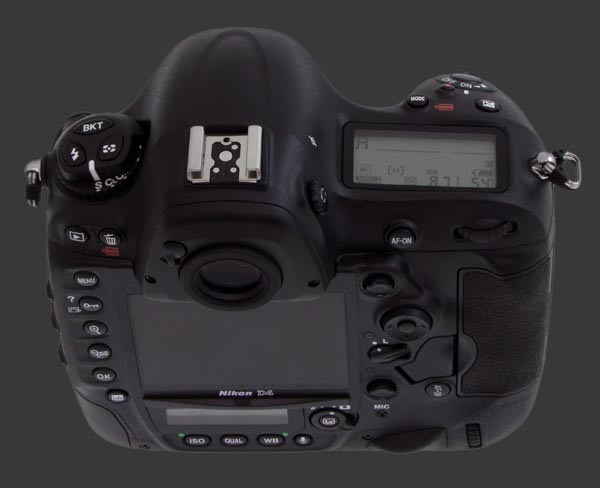
Metering patterns are chosen by a top-mounted button used with the rear control-dial. There are three choices: Matrix, Spot and Center-Weighed/Average. Matrix is Nikon's name for Multi-Segment metering and Spot is, well, Spot metering. Depending on a custom setting, the third choice activates Average metering or Center-Weighed. The same option lets the camera use one of four sizes8mm, 12mm, 15mm or 20mm for the central-portion.
Each AF-On button is customizable:
- AF-On - Triggers autofocus if neither camera nor lens are set to MF.
- AE/AF Lock - Locks both exposure and focus.
- AE Lock - Locks exposure only.
- AE Lock and Release - Locks exposure and keeps a shot is taken.
- AE Lock and Hold - Locks exposure and keeps it locked until pressed again. This is useful when taking multiple shots for stitching panoramas.
- AF Lock - Locks focus only.
Bracketing can be enabled for 2 to 9 frames with steps up to ±3 EV for 5 frames or less. A configuration option controls if flash power is adjusted for the bracket or if virtual bracketing for WB or ADL is performed instead. For WB bracketing, there are 3 step sizes. For WB, only one photo is taken but it is multiple times with different white-balance fine-tuning.
The standard ISO sensitivity range goes from 100 to 12800. Expanded ISO values are given labels instead. ISO 50 is called L 1.0. ISO 12800 is called H 1.0 all the way to H 4.0 for 204800. Auto ISO in PASM exposure modes works differently than on other brands of DSLRs. The user can configure a maximum ISO, minimum shutter-speed and ±2 for speed of raising the ISO. The D4 then adjusts the chosen ISO within the permitted range to obtain at least the specified shutter-speed.
White-balance options are plentiful. There are 2 types of Automatic WB. One tries to correct everything, the other leaves warm lighting intact. There are 6 presets With 7 sub-types for Fluorescent: Sodium-Vapor, Warm-White, White, Cool-White, Day-White, Daylight, High Temperature Mercury Vapor. and 4 custom white-balance memories. Choosing WB by color temperature in Kelvin degrees is also supported.
This camera features Nikon's Active D-Lighting image processing technology which lightens up dark areas of images to bring out details. There are 5 levels of ADL which differ by how much shadows get boosted. ADL can be manually or automatically set to one of those levels or turned off entirely. ADL indirectly affects RAW capture because exposure is adjusted according to the selected ADL level.
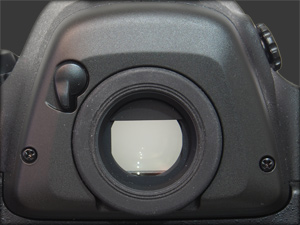 The Nikon D4 has a built-in viewfinder-shutter. It is opened and closed via a simple rotating switch next to the eye-piece. This shutter prevents light from entering the camera through the optical viewfinder. This avoids problems with long exposures or when bright light is shining there. Watch it close by hovering with the mouse cursor.
The Nikon D4 has a built-in viewfinder-shutter. It is opened and closed via a simple rotating switch next to the eye-piece. This shutter prevents light from entering the camera through the optical viewfinder. This avoids problems with long exposures or when bright light is shining there. Watch it close by hovering with the mouse cursor.
There are two memory-card slots on the D4, one accepts Compact Flash Type 1 cards and the other XQD cards. Either slot can be set as the Primary. This digital cameras makes excellent use of both slots, offering several modes of operation:
- Overflow: When one card fills up, start filling the other one. May help buying cheaper cards.
- Backup: Duplicate everything to both cards, ideally using cards of the same size and speed. This is the professional choice in case one card fails.
- Format-Separation: For RAW+JPEG shooters, RAW files go in the Primary slot and JPEG images in the other.
While having two memory-card slots is useful, using different types is a questionable choice which complicates media handling. XQD memory also lacks much support from card readers and other devices at this time.
This DSLR can capture JPEG images or RAW files, using the NEF format. The Nikon D4 can produce RAW files uncompressed, losslessly compressed or with lossy compression. Lossless compressive saves on average 40% space without any drop in quality, so this is the recommended option. All measurements here are done on losslessly compressed 14-bit per pixel RAW files. Optionally, RAW depth can be reduced to 12-bits per pixel. It saves around 20% space at the expense of 2 stops of precision.
The Nikon D4 can produce time-lapse video directly in-camera. This feature is discussed in the Video section on the last page of the D600 review.
As a professional took designed for fast photography, the D4 includes a large number of features to make desired settings active quickly. First is a set of 4 Memory Banks. Each bank remembers everything in the Shooting Menu with the exception functions that blend multiple images. Optionally, the memory banks can remember the exposure-mode with its primary exposure-parameter. For example, if it remembers that the camera was set to Aperture-Priority mode, it remembers the selected F-stop. There are also 4 banks for custom settings. Banks can be named and chosen independently for Shooting and Custom settings.
For tethered work, usually within a studio, the Nikon D4 incorporates a simple HTTP server. This is a web-server which serves some camera controls and Live-View as a video feed. This lets the camera be operated remotely from almost any device with a web-browser. Here is what it looks like with Google Chrome:
A Voice Memo function lets the photographer annotated images after taking them. Just press the Microphone button, speak and let go. This is valuable for all sorts of reasons, like remember why a photo was taken or what circumstances surround it. Voice memos are saves as separate WAV files.
A big part of professional work is delivering images. With such a high throughput, the D4 can produce gigabytes of them quickly. For this reason, this DSLR supports image transfer over Ethernet using a built-in FTP client. It even supports SFTP which transfers files securely. Of courses, image can be transferred by USB cable or by a card-reader.
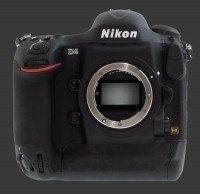 |
Please Support Neocamera
All information on Neocamera is provided free of charge yet running this website is a huge endeavor. Purchases made via affiliate links found throughout the site help keep it running and up-to-date. There is no additional cost to you, so please consider buying via these links to our affilates:
Thank you for your support!
Nikon D4 Highlights

Sensor-Size: 36 x 24mm

Actual size when viewed at 100 DPI
| 16 Megapixels DSLR | ISO 50-204800 |
| Nikon F Mount 1X FLM | Shutter 1/8000-30s |
| 100% Coverage Extra Large Viewfinder | Full manual controls, including Manual Focus |
| 2 Axis Digital Level | Custom white-balance with 2 axis fine-tuning |
| Weatherproof | Spot-Metering |
| Built-in Dust Reduction | Hot-Shoe & Sync-Port |
| 11 FPS Drive, 170 Images | Stereo audio input |
| 1920x1080 @ 30 FPS Video Recording | Lithium-Ion Battery |
| 3.2" LCD 920K Pixels | Compact Flash Type 1, XQD |
Updates
2025.11.13

Best Gifts for Photographers in 2025 by Budget
The annual Neocamera Photography Gift Guide updated to 2025. Find great gifts for photographers with any price budget.
2025.07.07

Stellar Photo Recovery Review
Review of Stellar Photo Recovery V12. This Windows and MacOS software can recover photos and videos in a huge number of formats from memory cards, USB drives, SSDs and HHDs.
2025.05.14

Huion Kamvas 13 Gen 3 Review
In-Depth review of the Huion Kamvas 13 Gen 3 Pen Display Tablet for photographers and graphic artists.
2025.01.18

Fujifilm GFX 2025 Lens Roundup
Lens Review roundup of Fujifilm GFX Medium-Format lenses. Quality, performance and handling of the GF20-35mm F/4R WR, GF30mm F/3.5 Tilt-Shift and the GF55mm F/1.7.
2024.11.18

Best 2024 Photography Gifts for Every Budget
Great gifts for photographers and photo enthusiasts selected for every budget among the best products of 2024.
2024.08.07

Eye Protection Tips for Professional Photographers
The four main considerations for professional photographers regarding eyewear.
2024.07.14

Fujifilm X100VI Review
Flagship fixed-lens compact digital camera with a 40 MP sensor and Image-Stabilization, a first for the series. Retro design featuring dual control-dials, plus direct ISO, Shutter-Speed and EC dials. Its hybrid viewfinder can switch between EVF and OVF mode.
2024.05.09

Fujifilm GFX100 II Review
Flagship 102 Megapixels Medium-Format Mirrorless Digital Camera with 8-Stop 5-Axis IBIS, 8 FPS Drive, 8K Video and 400 MP Super-Resolution capture in a weatherproof and freezeproof body with dual control-dials and dual memory-card slots.
2024.04.03

Fujifilm X-T5 Review
Newest Fujifilm flagship boasting a 40 MP APS-C sensor, 5-axis IBIS with 7-stop efficiency, 15 FPS continuous drive, 6.2K Video capture, dual control-dials and dual SDXC UHS-II slots in a sturdy weatherproof and freezeproof body.
2023.11.20

Best Digital Cameras of 2023
Find out which are the Best Digital Cameras of 2023. All the new Mirrorless Digital Cameras from entry-level to high-end professional.
2023.07.10

Fujifilm X-H2 Review
40 Megapixels APS-C Hybrid Mirrorless Digital Camera with 7-stop IBIS. Fastest shutter ever and 8K video capture. Large builtin EVF with 0.8X magnification and 5.8 MP, plus an Eye-Start Sensor. Packed with features and large number of controls in a weatherproof and freezeproof body.
2023.05.07

Sony FE 20-70mm F/4G Review
Review of the unique Sony FE 20-70mm F/4G lens. The optical zoom of this lens spans ultra-wide-angle and medium focal-length coverage, making it one of the most versatile Full-Frame lenses on the market.




